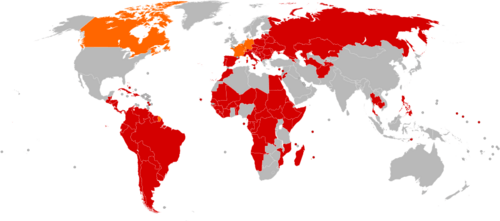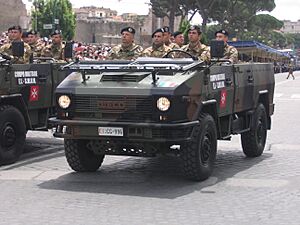Sovereign Military Order of Malta facts for kids
The Sovereign Military Order of Malta (often called the Order of Malta or Knights of Malta) is a very old Catholic group. It's like a special religious order, but its members are mostly lay people (not priests or nuns). Even though it doesn't have its own country, it's treated like a sovereign entity, meaning it can have diplomatic relations with other countries.
The Order started around 1099 in Jerusalem. Its main goals are to help people in need and to defend the Catholic faith. Its motto is "Defence of the faith and assistance to the poor." Today, the Order is famous for its huge humanitarian work around the world.
Quick facts for kids
Sovereign Military Hospitaller Order of Saint John of Jerusalem, of Rhodes and of Malta
|
|
|---|---|
|
Motto: Tuitio fidei et obsequium pauperum (Latin)
"Defence of the faith and assistance to the poor" |
|
|
Anthem: Ave Crux Alba (Latin)
"Hail, Thou White Cross" |
|
| Capital | Rome (Palazzo Malta 41°54′19″N 12°28′50″E / 41.90528°N 12.48056°E and Villa del Priorato di Malta 41°53′01″N 12°28′39″E / 41.88361°N 12.47750°E) |
| Official languages | Italian |
| Religion | Catholicism |
| Government | |
| John T. Dunlap | |
|
• Grand Commander
|
Emmanuel Rousseau |
| Riccardo Paternò di Montecupo | |
| Sovereign subject of international law | |
|
• Establishment of the Knights Hospitaller
|
c. 1099 |
| 1113 | |
|
• Cyprus
|
1291–1310 |
|
• Rhodes
|
1310–1523 |
|
• Malta
|
1530–1798 |
|
• Division
|
1805–1812 |
|
• Seat in Rome
|
1834–present |
| Area | |
|
• Total
|
0 km2 (0 sq mi) |
| Population | |
|
• Estimate
|
13,191 members (2023) 39 vowed members (33 knights; 6 chaplains) 3 citizens |
| Currency | Maltese scudo |
The Order has about 13,500 members, including Knights, Dames, and Chaplains. They work with 52,000 doctors, nurses, and paramedics, plus 100,000 volunteers in over 120 countries. They help children, homeless people, the disabled, the elderly, refugees, and those with serious illnesses. They help everyone, no matter their background or religion.
The Order also has diplomatic relations with 114 countries. This means they can sign treaties and issue their own passports, coins, and stamps. Their two main buildings in Rome are considered "extraterritorial," like embassies, meaning they are under the Order's authority, not Italy's.
Contents
Symbols and Flags
The Order of Malta has special symbols and flags. Its main flag is red with a white Latin cross. This cross is a simple, upright cross.
The flag used for the Order's work is also red, but it has a white eight-pointed Maltese cross. The eight points of this cross are said to represent the eight beatitudes from the Bible.
The Order's coat of arms usually shows a white cross on a red shield. This shield is often surrounded by a rosary and placed over a white eight-pointed cross, topped with a crown. These symbols help protect the Order's identity and heritage.
History of the Order
How the Order Began
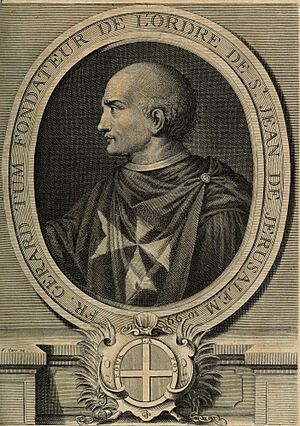
The Knights Hospitaller began around 1048. Merchants from Amalfi, Italy, got permission to build a church, a convent, and a hospital in Jerusalem. This hospital cared for pilgrims of all faiths and backgrounds.
The group running the hospital, led by a religious brother named Blessed Gerard, became independent. In 1113, Pope Paschal II officially approved the hospital. This meant it was under the Pope's protection and could choose its own leaders. The Knights were religious and promised to live simply, be pure, and obey.
During the Crusades, the Order also took on a military role. They defended the sick, pilgrims, and Christian lands. So, they added defending the faith to their mission of helping others.
Moving to New Homes
When the last Christian stronghold in the Holy Land fell in 1291, the Order moved to Cyprus.
Life on Rhodes
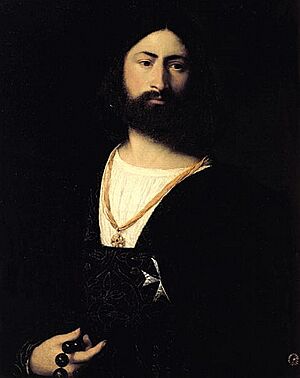
In 1310, the Knights moved to the island of Rhodes. From there, they built a strong navy to protect Christians in the Mediterranean Sea. They fought battles and helped defend Christian lands.
On Rhodes, the Knights were organized into groups called Langues (meaning "Tongues" or languages). Knights from different parts of Europe, like France, Italy, and England, belonged to different Langues. The Order was led by its Grand Master and a Council. They even had their own coins and made agreements with other countries.
In 1523, after a long siege by the Ottoman Empire, the Knights had to leave Rhodes.
The Time in Malta
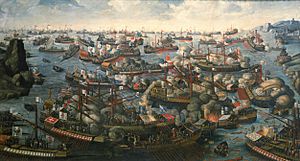
The Order didn't have a home until 1530. Emperor Charles V gave them the island of Malta. In return, the Order had to send a Maltese Falcon to the Emperor each year.
In 1565, the Knights, led by Grand Master Jean de Valette, bravely defended Malta during a huge siege by the Ottomans. The capital city of Malta, Valletta, is named after him.
The Order's fleet also helped defeat the Ottoman navy in the Battle of Lepanto in 1571.
Later, the Protestant Reformation caused some changes. Some parts of the Order became Protestant, but the main Order remained Catholic and tried to stay neutral in wars between Christian nations.
Leaving Malta and Finding a New Home
In 1798, Napoleon and his French army took over Malta. The Grand Master had to surrender, and the Knights were scattered.
Many Knights found shelter in Russia with Emperor Paul I. He even became a Grand Master for a time, though this was not officially recognized by the Catholic Church.
The Order was much weaker after losing Malta. For many years, it was led by temporary leaders instead of a Grand Master. But in 1879, Pope Leo XIII brought back the role of Grand Master. This helped the Order become strong again as a group focused on helping people.
In 1834, the Order moved its headquarters to Rome, Italy. Their main buildings there, Palazzo Malta and Villa del Priorato di Malta, have a special status, like embassies.
Modern Changes
In recent years, the Order has made some changes to its rules and leadership. The Pope has been involved in guiding these changes to help the Order continue its important work and stay true to its religious mission. For example, in 2022, Pope Francis approved a new constitution for the Order.
How the Order is Organized

The Order has a special way of governing itself, like a country, but also like a religious group.
Leadership
- The Prince and Grand Master is the head of the Order. He is like a leader of a country and also a religious leader. He is elected for a ten-year term. The current Grand Master is Fra' John T. Dunlap, elected in May 2023.
- The Sovereign Council helps the Grand Master run the Order's daily business.
- The Chapter General is like the Order's parliament. It meets every six years and elects members of the Sovereign Council.
Regional Groups
The Order is divided into different regions around the world. These include:
- Six Grand Priories (like the Grand Priory of Rome or Bohemia)
- Six Sub-Priories (like the Sub-Priory of St. Michael in Germany)
- Many National Associations in different countries.
Membership Types
Members of the Order belong to different classes and categories:
- First Class: These members make religious promises of poverty, purity, and obedience. They are called Knights of Justice or Professed Knights.
- Second Class: These members make a Promise of Obedience. They are called Knights and Dames in Obedience.
- Third Class: These members do not make vows or promises, but they follow the Church's and Order's principles. This is the largest group of members.
There are currently over 13,000 members in total.
Religious Leaders
The Order also has special religious leaders:
- The Cardinal Patron is a Cardinal appointed by the Pope. He helps with the spiritual side of the Order and its relationship with the Pope. The current Cardinal Patron is Gianfranco Ghirlanda, appointed in June 2023.
- The Special Delegate is also appointed by the Pope to help guide the Order.
- The Prelate is responsible for the Order's clergy (priests and chaplains).
International Connections
The Order is unique because it acts like a country on the world stage, even without its own land. This helps it do its humanitarian work without being tied to any one nation.
It has diplomatic relations with 114 countries and official relations with others, including the European Union. Many countries send ambassadors to the Order, just like they would to another country.
The Order also has a special "permanent observer status" at the United Nations General Assembly. This means they can attend meetings and contribute to discussions, especially on humanitarian issues.
The Order issues its own passports, license plates, postage stamps, and coins. These are mostly for official use or for collectors.
Military Corps
Even though the Order's main focus is now helping people, it still keeps its military title and traditions.
The Italian Knights of the Order have a special military unit called the Military Corps of the ACISMOM. This unit works with the Italian Army, providing medical support in both war and peace. They also take part in ceremonies for the Order. It's quite unique because a unit of one country's army is supervised by a group from another sovereign entity.
The Military Corps also operates a modern hospital train with many beds. This train can be used to transport and care for sick or injured people.
What the Order Does Today
The Sovereign Military Order of Malta is very active in humanitarian aid.
- Malteser International is a big part of the Order's work. It has over 140 projects in 35 countries across Africa, Asia, and the Americas. They provide emergency aid, help victims of natural disasters, and assist in areas affected by war or disease.
- They work with many partners, including governments and other aid organizations like Save the Children and CARE.
- In 2023, a large part of their funding came from the Government of Germany, showing how much countries trust their work.
The Order continues its mission of helping those in need around the world, following its long history of care and service.
Awards and Honors
The Order has its own awards, decorations, and medals, such as the Order pro Merito Melitensi. These are given to people who have done great service for the Order or for humanity.
See also
 In Spanish: Orden de Malta para niños
In Spanish: Orden de Malta para niños
- Knights Hospitaller
- List of Knights Hospitaller sites
- Order of Malta Ambulance Corps (Ireland)
- Sovereign State of the Bektashi Order




